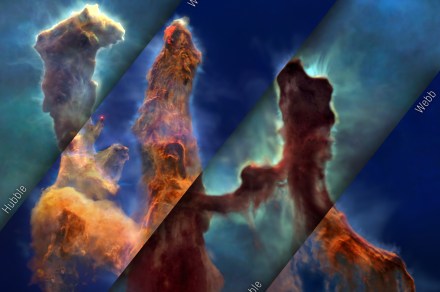See a stunning 3D visualization of astronomy’s most beautiful object


The Pillars of Creation are perhaps the most famous object in all of astronomy. Part of the Eagle Nebula, this vista was first captured by the Hubble Space Telescope in 1995, and has captivated the public ever since with its dramatic rising pillars of dust and gas that stretch several light-years high. The nebula has been imaged often since then, including again by Hubble in 2014 and more recently by the James Webb Space Telescope in 2022.
Now, scientists working with the Hubble and Webb telescopes have released a striking visualization, comparing the different views of the pillars taken by the two different space telescopes. If you’re wondering why scientists would bother taking many images of the same object with different telescopes, it’s sometimes because technology and processing has improved so much that it offers a better view (as was the case with the 1995 and 2014 Hubble images), and sometimes because different telescopes operate in different wavelengths of light so they can get different views of the object (as is the case with the Hubble and Webb images).

“When we combine observations from NASA’s space telescopes across different wavelengths of light, we broaden our understanding of the universe,” said Mark Clampin, Astrophysics Division director at NASA, in a statement. “The Pillars of Creation region continues to offer us new insights that hone our understanding of how stars form. Now, with this new visualization, everyone can experience this rich, captivating landscape in a new way.”

As well as comparing the images, the team from NASA has also created a 3D visualization of the pillars, showing what they look like from different angles.
“By flying past and amongst the pillars, viewers experience their three-dimensional structure and see how they look different in the Hubble visible-light view versus the Webb infrared-light view,” explained principal visualization scientist Frank Summers of the Space Telescope Science Institute (STScI) in Baltimore, who led the movie development team for NASA’s Universe of Learning. “The contrast helps them understand why we have more than one space telescope to observe different aspects of the same object.”
The Pillars of Creation: A 3D Multiwavelength Exploration
“The Pillars of Creation were always on our minds to create in 3D. Webb data in combination with Hubble data allowed us to see the Pillars in more complete detail,” said production lead Greg Bacon of STScI. “Understanding the science and how to best represent it allowed our small, talented team to meet the challenge of visualizing this iconic structure.”
NASA has even created a 3D printable model of the pillars for those who want to make their own model at home.
Editors’ Recommendations
-
Gorgeous Webb image of Serpens Nebula shows a strange alignment -
James Webb discovers the most distant galaxy ever observed -
James Webb observes extremely hot exoplanet with 5,000 mph winds -
See incredible time lapses of two of space’s most famous objects -
James Webb images capture the galactic winds of newborn stars

Georgina is the Digital Trends space writer, covering human space exploration, planetary science, and cosmology. She…
The expansion rate of the universe still has scientists baffled

The question of how fast the universe is expanding continues to confound scientists. Although it might seem like a fairly straightforward issue, the reality is that it has been perplexing the best minds in physics and astronomy for decades — and new research using the James Webb Space Telescope and the Hubble Space Telescope doesn’t make the answer any clearer.
Scientists know that the universe is expanding over time, but what they can’t agree on is the rate at which this is happening — called the Hubble constant. There are two main methods used to estimate this constant: one that looks at how fast distant galaxies are moving away from us, and one that looks at leftover energy from the Big Bang called the cosmic microwave background. The trouble is, these two methods give different results.
See what James Webb and Hubble are observing right now with this tool

If you’re looking for a relaxing way to peruse the fascinating sights of space on your lunch break, then a newly updated tool from NASA has you covered. The Space Telescope Live tools show the current targets of the James Webb Space Telescope and the Hubble Space Telescope, letting you browse the cosmos from the perspective of two of the hardest-working telescopes out there.
You can visit the web-based tools at WebbTelescope for the James Webb Space Telescope and HubbleSite for the Hubble Space Telescope. Clicking on a link will bring you to a portal showing the current and past observations of the telescope and a ton of detail about the observations.
This famous supernova remnant is hiding a secret

When massive stars reach the end of their lives and explode in a supernova, they can leave behind huge structures in space called supernova remnants. These are often favorite targets of astronomers because of their beautiful and distinctive shapes. They include the famous SN 1987A remnant that was imaged by the James Webb Space Telescope last year. Now, astronomers using Webb have peered closer at this remnant and found something special inside.
The SN 1987A supernova was first observed in 1987 (hence its name) and was bright enough to be seen with the naked eye, making it extremely recent by astronomical standards. Stars live for millions or even billions of years, so observing one coming to the end of its life in real time is a real scientific treat. When this star died, it created a kind of supernova called a core collapse, or Type II, in which the heart of the star runs out of fuel, causing it to collapse suddenly and violently. This collapse it so severe that the material rebounds and is thrown out in an explosion traveling up to a quarter of the speed of light.



